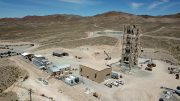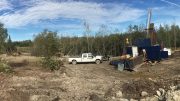DAWSON CITY, YUKON — Swooping in low via helicopter across wide, lush valleys at Atac Resources’ (TSXV: ATC; US-OTC: ATADF) well-established base camp on the Rackla gold project in the central Yukon, one can appreciate the scope of the vast 1,700 sq. km property package that hosts the impressive Osiris and Anubis clusters within the regional Nadaleen Trend.
Since 2010 the company has been advancing Canada’s first Carlin-type gold discoveries, and though the operation isn’t humming along at the rate it was during its heyday three years ago, it seems only a matter of time before the drills turn again in earnest.
Rackla became a hot story after the Nadaleen area was earmarked for grass-roots Carlin-type gold exploration. This was based on many analogous pathfinder-element anomalies in government databases from sediment samples collected from creeks draining the area — particularly because of the strong geological similarities between east-central Yukon and northeast Nevada.
Vice-president of exploration Julia Lane recounts over coffee that Atac’s geological team took a journey down to Nevada seven years ago to familiarize themselves with the regional geology. The area of the Yukon where Rackla sits has similar regional characteristics to the Carlin area, and historic prospectors had toyed with discovery models that would eventually lead to Atac’s success.
“We found high arsenic in till during regional stream sediment sampling just up the valley from where we’re standing. Three of us spent a day sampling our main drainages and found three anomalies. We confirmed the values in the Yukon database and they all came back looking really interesting,” Lane says.
“When we originally came to the project in 2007 it was always in the back of our minds that it has a similar setting to Nevada. We didn’t focus too much on comparisons to Goldstrike or Cortez, or something similar, because we were really using those regional characteristics to look for carbonate-replacement style discoveries,” she adds.
Arsenic ended up being Atac’s broadest pathfinder element, and led to the discovery of the Conrad zone in 2010. The company has since drilled nearly 75,000 metres at the target, highlighted by 43 metres of 18.44 grams gold per tonne in hole 12-114. Four zones now make up the 12 sq. km Osiris cluster, namely: Conrad, Osiris, Sunrise and Ibis.
Mineralization at Conrad is contained within several structural and stratigraphic settings.
In the Conrad Upper zone, gold mineralization occurs along the stratigraphic contact between limestone and an overlying pyritic siltstone cap unit, where the thickest mineralization occurs along the crest of an anticlinal fold. The Conrad Middle zone hosts strong alteration and mineralization within multiple stacked, flat-lying bodies proximal to a laterally extensive, near vertical siltstone-limestone contact.
Meanwhile, newly discovered gold mineralization below the Middle zone opens up an entirely new area for exploration. The Conrad Lower zone discovery in 2014 was highlighted by two new gold intervals that returned 42.7 metres of 3.03 grams gold and 21.7 metres of 3.15 grams gold.
“We have so many anomalies on the property that we’ve simply been too busy to follow up on due to how much we’ve been drilling since 2010,” Lane says, while pointing out the Nadaleen Trend along a ridge that’s visible from Atac’s core shack.
“Over the last couple of years, however, we’ve gone back out on the ground to figure some of them out and set up drill targets. During the heavy drill periods in 2012 and 2013, the property-wide data was just flowing in, so we have a wealth of information to study and hunt for new areas of interest,” she continues.
Roughly 10 km west of Osiris, along regional scale northwest-trending extensional faults, sits the Anubis cluster. The area hosts an 18 sq. km geochemical footprint with peripheral occurrences of high-grade silver-lead-zinc and gold mineralization that hint at Carlin-type mineralization, with a long-lived hydrothermal plumbing system. The Anubis zone discovery hole cut 8.5 metres of 19.85 grams gold, while rotary air-blast (RAB) drilling in 2015 intersected 47.2 metres of 3.79 grams gold.
“The Anubis area hosts nine targets, and that initial discovery was made pretty much in outcrop right in the side of that little creek bed you can see from here,” Lane says during a walking tour at Rackla. “We sampled our highest grades ever there in 2012, and we think there’s potential for a lot of gold in a broad system. It’s not as easy to follow-up on as Osiris, however, due to the amount of overburden we’re dealing with. So we use the cheaper RAB drills to narrow down our targeting to facilitate higher success rates with the more expensive diamond drills.”
Atac president and CEO Graham Downs says his company have curtailed its drilling rate at the project since markets tumbled two years ago. The company now leans on relatively cheaper exploration techniques to preserve its $16-million treasury in anticipation of a bounce back in gold markets.
But that didn’t stop Atac from making a discovery in mid-2015, when it carried out RAB drilling on the Orion target, 300 metres west of the Anubis zone. Hole 15-26 cut 47.24 metres of 3.79 grams gold at the target, with mineralization starting at 15.2 metres deep and continuing through the bottom of the hole.
“The key thing to take away from our programs last year was that significant discovery,” Downs says. “I can pretty much say we’re heading back out with the RAB drill, since it’s inexpensive, and we’ll try to get some ideas in terms of orientation and structure there. It’s absolutely wide open right now, so we’d like to do between 20 and 30 holes this year. Once we have those results we would move into diamond drilling if the results warrant.”
Mineralization at Orion occurs in both a debris flow-bearing fossiliferous limestone and a variably calcareous pyritic siltstone, but is most prevalent in a highly deformed and fractured structural setting in the hangingwall pyritic siltstone assemblage, where a secondary cross fault intersects the Anubis fault.
“Obviously if we can discover another trend, or a segment of a trend, that would be huge,” Lane says. “Other than that we’ll continue to focus on our advanced targets and moving towards resource estimates. But really it’s about filling an exploration pipeline, where we can generate excitement with discoveries.”
The wild card for Atac just may be the relatively unheralded Tiger sediment-hosted oxide gold deposit along the 20 km Rau Trend, which is a thick, northwest-trending body of carbonate-replacement style gold mineralization hosted within a moderately northeast-dipping horizon.
Mineralization develops around a zone of small-scale folding and shearing. The mineralized system is a series of stacked and folded limestone horizons interbedded with locally extensive mafic flows and volcaniclastic units.
The company hadn’t spent too much time on Tiger during its exploration boom years, when the more prolific Anubis and Osiris discoveries generated headlines. With lower gold prices and volatile markets, however, the prospect of a lower-cost, heap-leach focused mine could offer Atac some upside.
So the company’s 2016 exploration campaign will serve a dual purpose. First, Atac will follow-up on the Orion discovery with more RAB drilling; and second, it will extend soil sampling coverage around a newly identified 10 sq. km gold anomaly near Rackla’s airstrip, 4 km south of Tiger.
The new area could host gold sourced from a “favourable package” of variably calcareous sedimentary rocks similar to those seen in a trench at the company’s Bengal showing on the western end of the Airstrip anomaly.
“Tiger is a nice gem to have in our back pocket, and I think it will definitely be mined at some point. We found that new soil anomaly at the end of the season, so it needs a bunch more work,” Downs says. “At a minimum we’ll get an excavator in there to poke around. There will be plenty of follow-up geochemistry and prospecting, so there’s a big amount of work planned there this year. It’s pretty exciting stuff, and oxide gold is certainly popular right now.”
In mid-2014 Atac released a preliminary economic assessment at Tiger that models a hybrid heap-leach and carbon-in-leach operation with a $92.3-million capital expenditure. The 3,300-tonne-per-day mine would crank out 55,000 oz. gold annually based on oxide resources totalling 2.4 million indicated tonnes of 4.25 grams gold for 337,500 contained oz.
Assuming US$1,250 per oz. gold, Tiger features a $52.1-million pre-tax net present value at a 5% discount rate, along with a 30% internal rate of return and all-in sustaining costs of $626 per oz.
“The feedback we’ve been getting is to not spend a lot of our capital right now. We definitely have the deposits and targets to go out and spend millions of dollars on diamond drill campaigns, but we need to make sure we can be in a position to benefit if this market uptick proves sustainable,” Downs says.
“We’ve been in a bit of a holding pattern on Anubis and Osiris waiting for this market improvement. We need an indication we’ll generate value from any dollars spent there. Unfortunately we haven’t seen much love for exploration, regardless of what sort of intercepts you hit, but what we can do is generate discoveries,” he says.
Atac trades in a 52-week range of 25¢ to 62¢ per share, and jumped 24¢ to start the year and last traded at 56¢. The company had 118 million shares outstanding for a $70-million market capitalization.






Be the first to comment on "Site visit: Atac has more to discover at Rackla in Yukon"